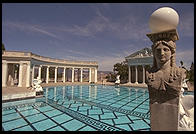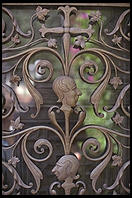

|
Acknowledgmentsby Philip Greenspun, part of Architecture and Implementation of Online Communities |
 Six years ago, I was struggling with my master's thesis. Under our
department's old rules, an SM thesis was supposed to be somewhat
original. Given MIT's tendency to collect intelligent, energetic,
testosterone-poisoned graduate students, the only way to retain the
respect of one's friends was to produce a master's thesis that would be
hailed as a great PhD thesis at any other school. If you were going to
expound a theory, something like Claude Shannon's 1938 master's
"Symbolic Analysis of Relay and Switching Circuits" would be expected.
Shannon was in our department and his master's transformed circuit
design from an art into a science and sparked a generation of engineers
into thinking that information per se could be manipulated by a
machine. If you were going to "build a kludge" for your master's then
it had to be the biggest and most complicated kludge every built.
Six years ago, I was struggling with my master's thesis. Under our
department's old rules, an SM thesis was supposed to be somewhat
original. Given MIT's tendency to collect intelligent, energetic,
testosterone-poisoned graduate students, the only way to retain the
respect of one's friends was to produce a master's thesis that would be
hailed as a great PhD thesis at any other school. If you were going to
expound a theory, something like Claude Shannon's 1938 master's
"Symbolic Analysis of Relay and Switching Circuits" would be expected.
Shannon was in our department and his master's transformed circuit
design from an art into a science and sparked a generation of engineers
into thinking that information per se could be manipulated by a
machine. If you were going to "build a kludge" for your master's then
it had to be the biggest and most complicated kludge every built.
Six years ago, Andy Berlin poked his head into my office and innocently asked me what I was doing. I explained that I'd finished writing up the Lisp Machine-based system I'd built for computer-aided design of earthmoving and real-time control of bulldozers. I was attacking all the unsolved problems in the field of computer-aided earthmoving. When I was done, I would simultaneously turn in the work as my master's thesis and as a manuscript to Prentice-Hall that would change the way everyone in the computer-aided engineering industry thought.
"Next year MIT is starting the M.Eng [five-year] program. They're going to be giving master's degrees to anyone who wanders into the wrong office in Building 38," Andy responded. "You'd be an idiot if you spent more than two weeks writing a master's thesis."
I deleted all the chapters that didn't directly relate to the program I'd written, printed out the shortened document, turned it into the library, and went off to New Zealand for two months. If not for Andy, I'd still be working on that book...
In August 1998, I was on the phone with Edward Tufte and mention my despair at getting over all of the graduation hurdles at MIT because I was so busy writing Web software and my comprehensive book on the theory and practice of Web application design.
Tufte said "Why don't you just turn in your book as your PhD thesis?"
I owe him a huge debt, both for his faith in this work and for his passion in arguing to make it better (sadly, I'm having to save most of his good ideas for the next magnum opus).
Most of my time as a graduate student was spent among the remarkably creative individuals assembled on the 4th floor by Hal Abelson and Gerry Sussman. Now that I'm supervising students of my own, I realize that the most valuable lesson I can learn from them is to have faith in people. Over the years, nearly every person on the 4th floor exhibited the hallmarks of stupidity, laziness, stubbornness, and uselessness. Yet not once did I ever hear Hal or Gerry say "I wish I never hired that stupid, lazy, stubborn, useless person." Nor do I think that they ever thought it. An experienced programmer training novices can fall prey to such thoughts very easily; it is so much faster to do everything oneself than to step a learner through the process. Hal and Gerry showed me that this is not the way and I hope to one day live up to their example.
My thesis committee chairman Patrick Winston has inspired me over the years. When I was an undergraduate, he inspired me with his book and his lecturing. When I was a researcher at the AI Lab, he inspired me with his example of leading a large organization without becoming a bureaucrat. Now that he's stepped down as lab directory and I've graduated, he inspires me with his continued attack on the hard problem of understanding human cognition. Seemingly everyone else has found it expedient to give up on this problem, but Patrick perseveres. That's what separates Academia from Industry.
As an undergraduate at MIT, I was inspired by Tom Knight's creations, the Knight TV and the Lisp Machine. I chose programming as a career because I was so in love with the power of the Lisp Machine. As a young graduate student, I would go to Knight when I needed a clear exposition of topics ranging from the Sampling Theorem to digital computer architecture. As I started to build my research group, I was inspired once again by Tom Knight's example. Here is a man who generates enough good ideas to push five or ten students out of our doors with PhDs yet who is generous enough that he lets them take all the credit for the work.
My third committee member, Gill Pratt, is about my age. So I'm not going to say that he has inspired me. What do I like about Gill? His devotion to the community of nerds. His setting an example in the academic computer science field by actually sitting down and programming, building circuits, or building robots.
Dave Staelin showed me how creativity can triumph over bureaucracy. It is no accident that I graduated four months after he became my academic advisor.
Since 1976, it has been my privilege to be part of the MIT computer science community, physically rooted at 545 Technology Square. Although we've spent most of the past three decades trying to figure out how to get the ventilation system to stop hissing (with nobody except Tom Knight having any success), it is tough for most people to imagine a building where a young nerd can walk out of his office on the 4th floor, argue with the founder of the free software movement (Richard Stallman), annoy the authors of the best computer science book ever written (Abelson and Sussman), walk up one floor to run a few ideas past Dave Clark, Chief Protocol Architect for the Internet from 1981-1989, and walk down two floors to talk to Tim Berners-Lee, developer of the World Wide Web.
Rather than thank each person individually, I will note that I would surely have failed my thesis defense if not for Kleanthes Koniaris, a major factor in Anita Flynn's dubbing us "the High Testoterone floor". KGK came back from California to hear my practice talk at around midnight, the night before the defense. While my friends were applauding me, KGK went through his four pages of notes on the talk's organizational flaws. When I proposed that we all get a good night's rest, he quoted a Marine drill sergeant: "You'll have plenty of time to sleep in the grave."
KGK's exhortation inspired me to work with him until 3:00 am resequencing the slides and adding context. But upon further reflection, I've realized that he was saying something profound about why students come to MIT in the first place: "We'll have plenty of time to sleep in the grave."